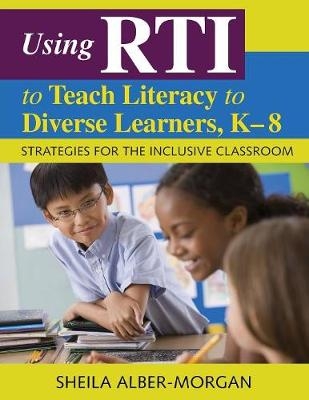
Using RTI to Teach Literacy to Diverse Learners, K-8
Corwin Press Inc (Verlag)
978-1-4129-6952-9 (ISBN)
"In a small volume, Sheila Alber-Morgan addresses RTI in a much more comprehensive way than other texts. The book provides critical features of RTI across reading, writing, handwriting, and spelling and is packed with practical information for each tier."
—Nancy L. Cooke, Associate Professor of Special Education
University of North Carolina at Charlotte
"Alber-Morgan clearly and concisely articulates the theoretical and empirical bases of RTI—an important and worthy achievement. For the classroom teacher, her book provides numerous assessment and instructional strategies for turning the great promise of RTI into reality for students."
—William L. Heward, Professor Emeritus
The Ohio State University
Practical intervention strategies for diverse learners who struggle with literacy!
Literacy is a critical foundational skill for success in school and throughout adulthood. Covering both reading and writing instruction, this book shows K–8 teachers how to build the literacy skills of diverse learners, including those with disabilities and those from culturally and linguistically diverse backgrounds, in inclusive classrooms.
Sheila Alber-Morgan discusses instruction and assessment within a Response to Intervention (RTI) framework and demonstrates how to provide targeted support to students struggling with literacy or those who may require special attention to achieve success. Providing specific interventions for tiers 1, 2, and 3, this book offers:
Evidence-based practices such as guided note taking, the use of response cards, peer-mediated instruction, self monitoring, and direct instruction
Strategies for phonemic awareness, fluency, vocabulary, and comprehension
Methods for teaching handwriting, spelling, keyboarding, and the writing process
A discussion on using thematic units to integrate reading and writing
With sample assessments, graphic organizers, and brief case studies of students, this timely volume assists teachers and literary specialists in providing the support that diverse learners need to succeed.
Sheila Alber-Morgan has been an associate professor of special education at The Ohio State University since 2005. She was also a faculty member at The University of Southern Mississippi for eight years. After teaching for several years in inclusive classrooms in both urban and rural South Carolina, Dr. Alber-Morgan began doctoral training at The Ohio State University and earned her Ph.D. in 1997. For the past 15 years, Dr. Alber-Morgan’s research has focused on examining the effects of various literacy interventions on the learning outcomes of elementary and secondary students with and without disabilities. Additionally, her research incorporates strategies for programming for generalization and maintenance of academic and social skills. Almost all of Dr. Alber-Morgan’s research has been designed and implemented in collaboration with classroom teachers, and she has over 50 research and practitioner publications including peer reviewed journal articles, textbook ancillaries, and book chapters.
Acknowledgments
About the Author
1. Overview
Universal Design and Response to Intervention
Diverse Learners and Inclusive Classrooms
NCLB and Evidence-Based Practices
Special Education Law
RTI and Assessment
Curriculum-Based Measurement
RTI and Literacy Instruction
Explicit Instruction and Active Student Responding
Peer-Mediated Instruction
Integrating Language Arts
Programming for Generalization
Collaborative Teaching
Summary
2. Assessing for Intervention in Reading
RTI and CBM reading
CBM Reading Methods
Oral Reading Fluency
CBM Maze
CBM Early Reading
Vocabulary Matching
Miscue Analysis and Comprehension Checks
Authentic Assessment
Summary
Maya
3. Implementing Multi-Tiered Reading Instruction
Evidence-Based Practices
Reading Instruction: Tier 1
Reading Instruction: Tiers 2 & 3
Phonemic Awareness: Tier 1
Phonemic Awareness: Tiers 2 & 3
Alphabetics: Tier 1
Alphabetics: Tiers 2 & 3
Fluency: Tier 1
Fluency: Tiers 2 & 3
Vocabulary: Tier 1
Vocabulary: Tiers 2 & 3
Comprehension: Tier 1
Comprehension: Tiers 2 & 3
Summary
Alexei
4. Assessing for Intervention in Writing
RTI and Writing Assessment
CBM Writing Measures
Managing CBM Writing
Writing Rubrics
Portfolios
Summary
Dylan
5. Implementing Multi-Tiered Writing Instruction
Evidence-Based Practices
Handwriting Instruction: Tier 1
Handwriting Instruction: Tiers 2 & 3
Keyboarding Instruction
Spelling Instruction: Tier 1
Spelling Instruction: Tiers 2 & 3
Writing Process: Tier 1
Writing Process: Tiers 2 & 3
Computer Technology for Writing: Tier 1
Computer Technology for Writing: Tiers 2 & 3
Summary
Carmen
6. Using Thematic Units to Integrate the Language Arts
Creating Thematic Units for Multi-Tiered Instruction
Selecting a Theme
Identifying and Obtaining Resources and Materials
Identifying Language Arts Skills
Planning Multi-Tiered Instruction
Summary
7. Programming for Generalization of Literacy Skills
Selecting Representative Teaching Examples
Making the Classroom Resemble Generalization Settings
Providing Students with a Means to Access Reinforcement
Arranging Ways to Transfer Skills to Different Settings
Training Students to Transfer Skills
8. Closing the Research to Practice Gap
References
Index
| Erscheint lt. Verlag | 8.6.2010 |
|---|---|
| Verlagsort | Thousand Oaks |
| Sprache | englisch |
| Maße | 215 x 279 mm |
| Gewicht | 420 g |
| Themenwelt | Schulbuch / Wörterbuch |
| Sozialwissenschaften ► Pädagogik ► Didaktik | |
| ISBN-10 | 1-4129-6952-2 / 1412969522 |
| ISBN-13 | 978-1-4129-6952-9 / 9781412969529 |
| Zustand | Neuware |
| Haben Sie eine Frage zum Produkt? |
aus dem Bereich


